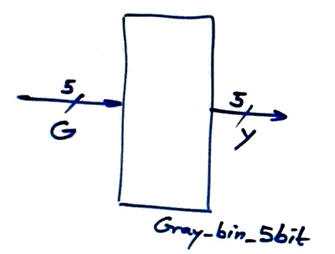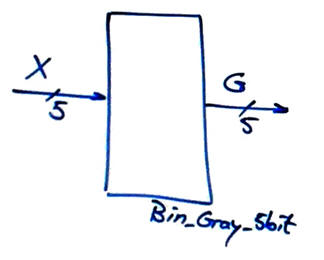|
|
|||||
Chapter 3 problems |
- B3.12 - |
5-bit Gray to binary and binary to Gray code converters |
|||
|
|
|||||
Project option #1: 5-bit Gray to binary converter Project option #2: 5-bit binary radix-2 to Gray converter
Design the 5-bit Gray to binary radix-2 code converter represented in Fig. 1 using plan B and a microcontroller PIC18F4520.
The same project is proposed in D1.12 as a combinational circuit based on logic gates.
 |
Fig.1. Symbol of the Gray_bin_5bit converter. |
Use this project to review basic concepts on μC as theory attached to the specifications section.
2. Planning
A) Planning hardware
Copy and adapt a circuit from any of the previous projects (LAB9) and name it Gray_bin_5bit.pdsprj. Assign pins to inputs and outputs accordingly to one of the following options (your instructior will tell you which):
Pin assignment option #1:
G4 --> RC7; G3 --> RC4; G2 --> RC3; G1 --> RB6; G0 --> RA1
Y4 --> RA3; Y3--> RC5; Y2 --> RD7; Y1 --> RD2; Y0 --> RB1
Pin assignment option #2:
G4 --> RC6; G3 --> RC7; G2 --> RD3; G1 --> RB4; G0 --> RA0
Y4 --> RA2; Y3--> RD5; Y2 --> RB7; Y1 --> RD2; Y0 --> RC1
Pin assignment option #3:
G4 --> RB7; G3 --> RC2; G2 --> RC1; G1 --> RD6; G0 --> RA2
Y4 --> RA0; Y3--> RC3; Y2 --> RD4; Y1 --> RD1; Y0 --> RA2
Project location:
C:\CSD\P9\Gray_bin_5bit\(files)
B) Planning software
Organise the main program in our CSD way.
Propose a hardware-software diagram naming all the electrical signals, RAM variables and the software functions.
Explain how to configure the µC in init_system(). List all RAM variables required and their type.
Organise using a flowchart the interface function read_inputs().
Organise using a flowchart the interface function write_outputs().
Infer the truth_table() software function using a behavioural interpretation and the corresponding flowchart.
Developing & testing (debugging)
Write the Gray_bin_5bit.c source code translating the function flowcharts. Start capturing only one input as in (LAB9) and visualising it in the watch window. And only then go step by step developing & testing more inputs.
Start a software IDE project for the target microcontroller PIC18F4520 and generate the configuration files ".cof" and ".hex" after compilation. Discuss the project summary: % of ROM used for the code, number of RAM bytes used, etc.
Add a few lines of code every time, compile and run the test intereactively to check results watching variables.
| Note: Step-by-step tactical approach for developing and testing the project: Read one input at a time and run to check that the voltage value is correctly captured as a valid digital value in RAM memory. Write one output at a time and run to check that your code is correct to light the LED connected at the output pin. |
Measure how long does it take to run the main loop code when using a 4 MHz and a 20 MHz crystall oscillators.
Project option #2: 5-bit binary radix-2 to Gray code converter
1.- Specifications
Design the 5-bit binary radix-2 to Gray code converter represented in Fig. 1 using plan B and a microcontroller PIC18F4520. The same project was proposed in D1.12 as a combinational circuit based on logic gates.
 |
Fig.1. Symbol of the Bin_Gray_5bit converter. |
Use this project to review basic concepts on μC as theory attached to the specifications section.
2. Planning
A) Planning hardware
Copy and adapt a circuit from any of the previous projects (LAB9) and name it Bin_Gray_5bit.pdsprj. Assign pins to inputs and outputs accordingly to one of the following options (your instructior will tell you which):
Pin assignment option #1:
X4 --> RA3; X3--> RC5; X2 --> RD7; X1 --> RD2; X0 --> RB1
G4 --> RC7; G3 --> RC4; G2 --> RC3; G1 --> RB6; G0 --> RA1
Pin assignment option #2:
X4 --> RA2; X3--> RD5; X2 --> RB7; X1 --> RD2; X0 --> RC1
G4 --> RC6; G3 --> RC7; G2 --> RD3; G1 --> RB4; G0 --> RA0
Pin assignment option #3:
X4 --> RA0; X3--> RC3; X2 --> RD4; X1 --> RD1; X0 --> RA2
G4 --> RB7; G3 --> RC2; G2 --> RC1; G1 --> RD6; G0 --> RA2
Project location:
C:\CSD\P9\Bin_Gray_5bit\(files)
B) Planning software
Organise the main program in our CSD way.
Propose a hardware-software diagram naming all the electrical signals, RAM variables and the software functions.
Explain how to configure the µC in init_system(). List all RAM variables required and their type.
Organise using a flowchart the interface function read_inputs().
Organise using a flowchart the interface function write_outputs().
Infer the truth_table() software function using a behavioural interpretation and the corresponding flowchart.
Developing & testing (debugging)
Write the Bin_Gray_5bit.c source code translating the function flowcharts. Start capturing only one input as in (LAB9) and visualising it in the watch window. And only then go step by step developing & testing more inputs.
Start a software IDE project for the target microcontroller PIC18F4520 and generate the configuration files ".cof" and ".hex" after compilation. Discuss the project summary: % of ROM used for the code, number of RAM bytes used, etc.
Add a few lines of code every time, compile and run the test intereactively to check results watching variables.
| Note: Step-by-step tactical approach for developing and testing the project: Read one input at a time and run to check that the voltage value is correctly captured as a valid digital value in RAM memory. Write one output at a time and run to check that your code is correct to light the LED connected at the output pin. |
Measure how long does it take to run the main loop code when using a 4 MHz and a 20 MHz crystall oscillators.


